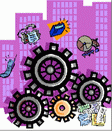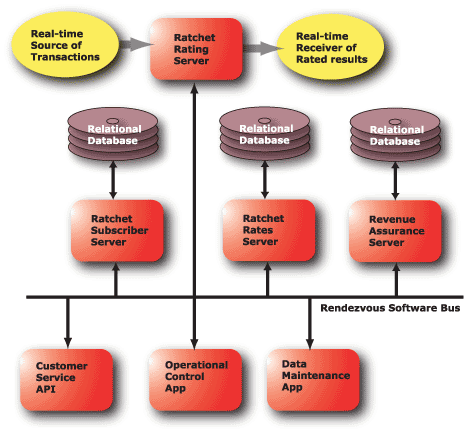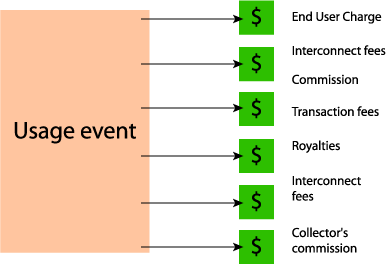
RATCHET™
Rating System ![]() (print
version)
(print
version)

Figure 1. Architecture of Ratchet™ Rating System
The Ratchet™ Rating system is a multipurpose real-time rating system for business transactions. It is most useful for usage transactions, such as telephone calls, wireless calls, wireless IP usage transactions, utilities transactions (water, gas, electricity), etc.
Real-Time, Interactive & Batch Together
Ratchet™ processes real-time transaction flows in concert with batches of transactions. Real-time queries (like prepaid rating) are answered in real-time. Batch processing fills in the gaps.
Your legacy applications can use the rater and its information via its message-based interface. Your customer service representative application can get a rate quote or get detailed information on how a transaction was rated. All of these interactive service actions continue without interrupting the production processing of transactions.
Rule Driven Solution
Using a strong rules-oriented environment gives you the ability to see the inner workings of the rating process to debug and understand your rules. You can see a detailed trace of the evaluation of all the rules that were applied to any transaction.
We employ rules at several transaction processing levels. The first level identifies the type of input transaction and specifies the charges that may apply using your rule definitions. Using a wireless example, when we see a phone call record, we examine its contents and determine that charges for roaming, long distance, and airtime might apply.
The next layer of rules rates these chargeable services based on information from the customer account. Because of the customer plan information, some services may not be charged for, but you can separate the decision that a service was provided from the calculation of the cost for that service. This also allows you to calculate payments to others for a service that you've bundled into a recurring charge.
A third level of rules creates one or more outputs from the rating process in a format you define. You can send data to your billing application in one format and then send the same data in a different format to your data warehouse or to your content provider. We use this approach because of the multi-layer complexity in wireline, wireless and the IP services business.
Figure 2. Data conversion by rules
Units of Measure Defined by You
You define the unit of measure used in the rating processes. Thus, you can charge for a service transaction in the unit of measure related to its value to your customers. For GPRS, UMTS, and 3G, you might choose to use bytes, packets, messages, megabytes, or content-specific units of measure. For phone calls, the unit of measure will probably be duration. For IP fax store-and-forward, you might instead charge by the page transmitted. For Application Service Providers, the units of measure may relate to the functions performed for the customer.

Figure 3. Generation of
billing records to support value chain
Value Chain Support
You can define rules to take a single usage event and generate multiple billing records to cover both the retail charging and the charging and/or payments (credits and debits) to other parties to the service. For example, a transaction can spin-off royalty payments, transaction fees, interconnect fees, collector's commissions, advertising commissions, hosting charges, end-user charges, etc.
Various Pricing Plans
Methods of rating include, but are not limited to, flat rate, time of day, day of week, distance based, duration based, tier/volume, tapered, transition, mobile-to-mobile, zone based, called number pricing, and user defined variable controlled. These rate plans rate based on your definitions of units of measure. Thus, you can rate local and long distance calling, wireless calling, data transmissions, fax store-and-forward, and Internet transactions.
Data Suppliers Ready To Help
The rate tables are rule-based definitions that you can change. To reduce the amount of labor involved in maintaining telecommunications tariffs, we have partnerships with CCMI (Center for Communications Management Information) and International DataBases (a tariff database provider) to provide compatible data to update the public portion of the tariff data and the public rates of competitive suppliers.
System Performance
When optimally configured, Ratchet™ processes more than four million transactions per hour (1,100 transactions per second) on a single Pentium IV processor. When you need more transactions processed per hour, you simply add more processors. With eight processors, you will process more than thirty-two million transactions per hour.
The Technology
RATCHET™ employs the TIBCO Rendezvous Software Bus to support its messaging and processing distribution needs. The diagram for RATCHET™ shows one of each type of process. Keep in mind that RATCHET™ allows multiple parallel implementations of all the applications shown. The messaging protocol provides a smooth growth path from single process implementations for smaller users to multi-process parallel implementations for large users.
The Ratchet™ Rater can run on XP, Solaris, Linux, and most UNIX operating systems. This multithreaded application caches the data needed for the rating process in RAM.
The Ratchet™ Rates Server and the Ratchet™ Subscriber Server are application-specific data servers. They connect to a commercial relational database server (i.e. SQL Server, Oracle, etc.) on one side and provide data objects in messages to the Ratchet™ applications on the other side.
The Ratchet™ Revenue Assurance Server stores the transactions that have been successfully rated you can easily re-rate selected transactions. It also stores and manages the rating errors encountered by the Ratchet™ Rating Server.
The Ratchet™ Operational Control application and the Rate Maintenance application are implemented as Java applications. This allows cross-platform use of these applications along with the opportunity to distribute the applications geographically on your intranet or on the Internet. Service Level LLC can, with your permission, access these applications remotely and provide “high touch” support.
More Information
You can learn more about the Ratchet Rating solution at http://www.servicelevel.net/. The product and its implementation support team make a success of your implementation. You can contact our representatives at sales@www.servicelevel.net
Service Level LLC
7006 Suncrest Drive
Saline, MI 48176
+1 734-827-2000 (voice)
+1 734-827-2200 (fax)
Time Zone: same as New York City


